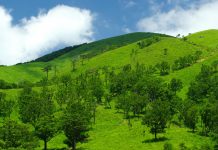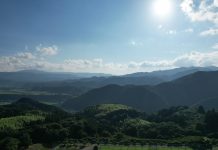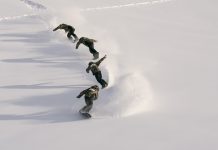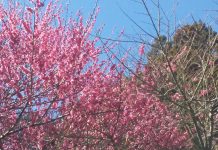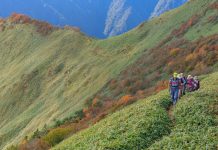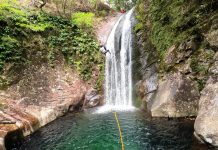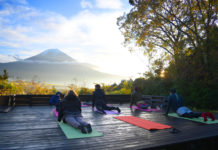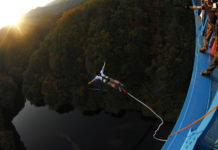Welcome to Pauline’s Pera Pera Corner – Lesson #2. Last month, I armed you with a verbal first aid kit to take with you while hiking, but this month we’ll explore some words of encouragement and praise you can generously dish out to that special someone in need.
Encouragement. Utter amazement. Genuine praise. Do you need a way to express these above feelings? Ah, well, perhaps Pauline Sensei can help.
The most commonly used phrase to offer encouragement is ganbatte (頑張って) which means good luck, or literally (and kind of bluntly), “try hard.” This versatile phrase can be used in practically any type of situation requiring encouragement whether it be before an exam, job interview or before a competition. For example, if I’m about to head off to a MTB race, you can wish me luck by saying “Pauline, ganbatte!!!”(ポーリン、頑張って!!!).
You can also use the word ouen (応援) which means “to cheer on someone.” For example, “Pauline, ouen shiteiruyo!” (ポーリン、応援しているよ; Pauline, I’m cheering you on!) Of course, I’ll show my appreciation for your kind support by slightly bowing (in a very Japanese-like manner) and saying “arigato” (ありがとう; thank you) or I may just give you a good ‘ole North American hug and a great big sankyu (サンキュー) which is, by the way, the Japanese way of saying the English word, “Thank you.”
Once the MTB race starts, you’ll soon notice I’m woefully struggling at the back of the pack. If you ask me how I’m doing, I’ll probably cry out “Kitsui” (キツイ; It’s tough) or “Taihen” (大変; It’s hard). If I’m really hurting, I’ll probably grimace and throw in a totemo (とても; very)in front like this: Totemo kitsui! Totemo taihen!
Obviously at this point, a little bit more positive encouragement wouldn’t hurt. Feel free to shout out ganbare! (頑張れ; Come On!) which is a variation on ganbatte. You could also command me to faito! (ファイト!). Similar to “sankyu,” this is the Japanese way of saying the English word “fight” and basically means “Keep at it!”
Your words of encouragement are helpful and, before you know it, I’m unbelievably challenging for the lead. If you’re as amazed as me by this incredible comeback, go ahead, boost my ego by saying “Sugoi” (すごい; Amazing!) and gleefully shouting out “Iizo” (いいぞ; Good going!). If you’re feeling particularly passionate, double it up for even further emphasis: sugoi, sugoi (すごい、すごい), iizo, iizo (いいぞ、いいぞ).
By the way, “sugoi” is a proper and gender-neutral term used by both men and women. However, you may want to experiment with a few other “sugoi” slang variations just for fun. For instance, sugeh (すげぇ) or even better (or worse?!), the “ultra-slang” sungeh (すんげぇ). Both mean “amazing” but are “guy words” generally used by the younger folk. Nowadays though, you can often overhear young women using sugeh and sungeh as well…not necessarily very ladylike in my opinion, but hey…
I fought hard. You cheered me on with your effective Japanese phrases and, oh yes, Pauline Sensei reaches the finish line in first place! Woo hoo. A champion is born! Yattane (やったね; Well done)! High Five!
And so I wish. Maybe one day…dream on Pauline, dream on.
WHAT’S THE WORD?
頑張って (Ganbatte) 頑張れ (Ganbare) = Good luck OR Best of luck
応援しているよ (Ouen shite iruyo) = I’m cheering you on
ありがとうございます (Arigato gozaimasu) ありがとう (Arigato) サンキュー(Sankyu) = Thank you, Thanks a lot
とてもキツイ (Totemo kitsui) とても大変 (Totemo taihen!) = It’s very toughIt’s very difficult
ファイト! (Faito) = Keep at it! OR Come on fight!
すごい (Sugoi)すげぇ (Sugeh) slang すんげぇ (Sungeh) slang = Amazing / Fantastic/ Excellent / Great / Awesome
いいぞ (Iizo) = Good going
やったね (Yattane) = Well done OR Good job
又は = High Five, Gimme Five
Pera Pera = to speak fluently; to blab; to blabber; Blabber Blabber
Pauline Kitamura: Looks Japanese, Speaks Japanese and even writes Japanese, but is truly Canadian. Pauline moved from Vancouver three years ago and has been romping around the great Japanese outdoors ever since.



